NVIDIA GeForce GTX 670 Review Feat. EVGA: Bringing GK104 Down To $400
by Ryan Smith on May 10, 2012 9:00 AM ESTOC: Power, Temperature, & Noise
Our final task is our look at GTX 670’s overclocking capabilities. Based on what we’ve seen thus far with GTX 670, it looks like NVIDIA is binning chips based on functional units rather than clockspeeds. As a result GTX 670 could have quite a bit of overclocking potential, albeit one still limited by the lack of voltage control.
| GeForce 600 Series Overclocking | |||||
| GTX 670 | EVGA GTX 670SC | GTX 680 | |||
| Shipping Core Clock | 915MHz | 967MHz | 1006MHz | ||
| Shipping Max Boost Clock | 1084MHz | 1188MHz | 1110MHz | ||
| Shipping Memory Clock | 6GHz | 6GHz | 6GHz | ||
| Shipping Max Boost Voltage | 1.175v | 1.162v | 1.175v | ||
| Overclock Core Clock | 1065MHz | 1042MHz | 1106MHz | ||
| Overclock Max Boost Clock | 1234MHz | 1263MHz | 1210MHz | ||
| Overclock Memory Clock | 6.9GHz | 6.6GHz | 6.5GHz | ||
| Overclock Max Boost Voltage | 1.175v | 1.162v | 1.175v | ||
Because of the wider gap between base clock and boost clock on the GTX 670 we see that it doesn’t overclock quite as far as GTX 680 from a base clock perspective, but from the perspective of the maximum boost clock we’ve slightly exceeded the GTX 680. Depending on where a game lands against NVIDIA’s power targets this can either mean that an overclocked GTX 670 is faster or slower than an overclocked GTX 680, but at the same time it means that overclocking potential is clearly there.
We’re also seeing another strong memory overclock out of a GK104 card here. GTX 680 only hit 6.5GHz while GTX 690 could hit 7GHz. GTX 670 is only a bit weaker at 6.9GHz, indicating that even with the relatively small PCB that NVIDIA can still exceed the high memory clocks they were shooting for. At the same time however this is a luck of the draw matter.
The EVGA card meanwhile fares both worse and better. Its gap between the base clock and and maximum boost clock is even larger than the reference GTX 670, leading to it having an even lower overclocked base clock but a higher overclocked maximum boost clock. The real limiting factor however is that it couldn’t reach a memory overclock quite as high as the reference GTX 670 – again, luck of the draw – which means it can’t match the overclocked reference GTX 670 as it’s going to be more memory bandwidth starved more often.
Moving on to our performance charts, we’re going to once again start with power, temperature, and noise, before moving on to gaming performance. We’ll be testing our GTX 670 cards at both stock clocks with the maximum power target of 122% (170W) to showcase what is possible at validated clockspeeds with a higher power cap, and a true overclock with a maximum power target along with the largest clock offsets we can achieve.
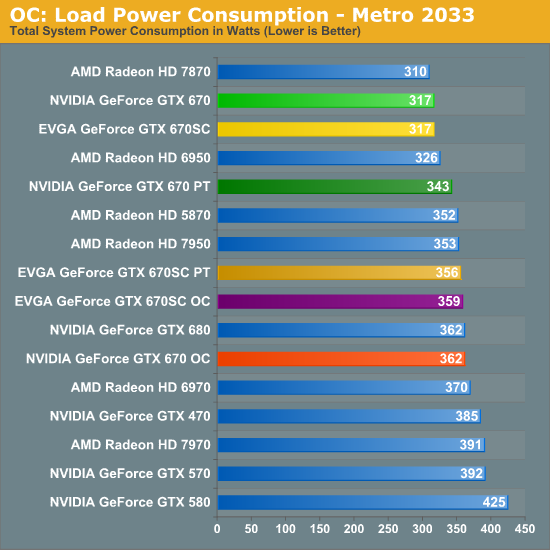
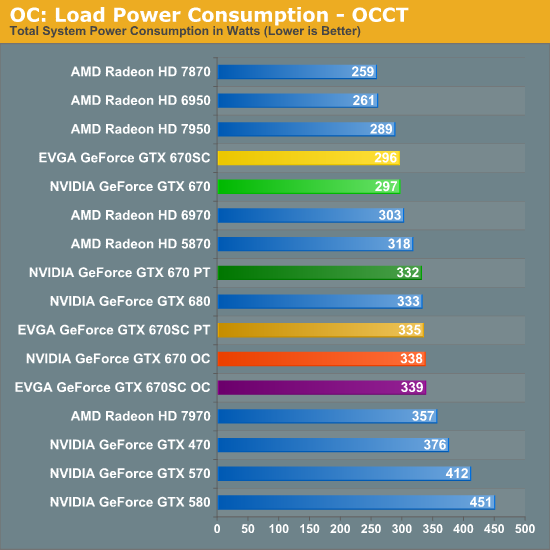
Not surprisingly, since we’re almost always operating within the realm of the power target as opposed to the TDP on the GTX 600 series, our power consumption closely follows our chosen power target. Cranking up the power target on the GTX 670 for example to 170W puts us within 6W of the GTX 680, which itself had a 170W power target in the first place. This is true for both Metro and OCCT, which means power consumption is very predictable when doing any kind of overclocking.
This also means that power consumption is still 18W-30W below the 7970, which in turn means that if these overclocks can close the performance gap, then the GTX 670 still has a power consumption advantage.
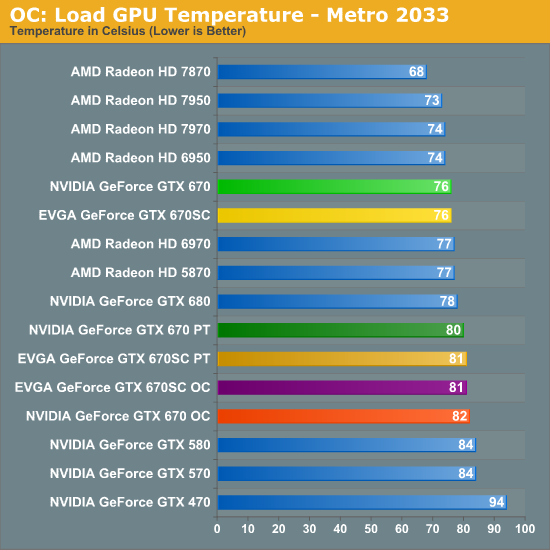
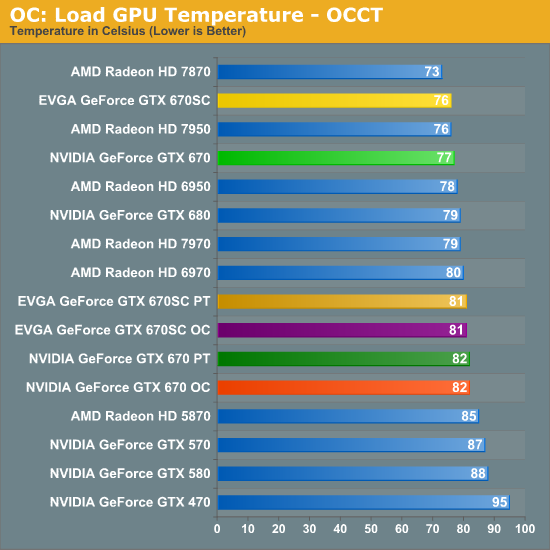
As to be expected, with an increase in power consumption comes an increase in load temperatures. However the fact that we’re only able to increase power consumption by about 30W means the temperature rise is limited to 4-5C, pushing temperatures into the low 80s. This does end up being warmer than the equivalent GTX 680 however due to the 680’s superior heatsink.
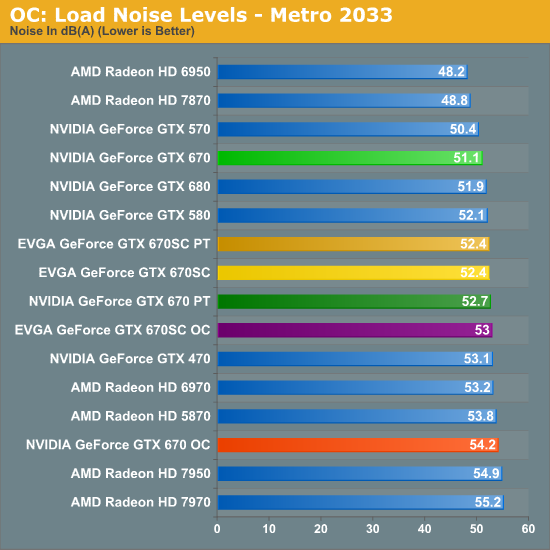

Finally, when it comes to noise we’re also seeing the expected increase, but again it’s rather small. Under Metro the amount of noise from the reference GTX 670 rises by under 3dB when pushing the power target higher on its own, while it rises 3dB when adding in our full overclock. Again the smaller cooler means that the GTX 670’s fan has to work harder here, which means our gaming performance may be able to reach the GTX 680, but our noise is going to slightly exceed it. As a point of reference, in the process we’ll also exceed the GTX 580’s noise levels under Metro. Still, in both OCCT and Metro none of our GTX 670 cards exceed the Radeon HD 7900 series, which means we've managed to increase our performance relative to those cards without breaching the level of noise they generate in the first place.










414 Comments
View All Comments
SlyNine - Saturday, May 12, 2012 - link
I'm starting to think you're alittle crazy.CeriseCogburn - Sunday, May 13, 2012 - link
Say it 3 more times ( as you have already), it certainly invalidates all the reasons why the amd card loses badly.Nice, desperate try there. Not.
medi01 - Friday, May 11, 2012 - link
Let me guess: because you can actually get either 680 or 670 at the announced price (if at all), eh?So you can't? And when you will be able to get one, street price would probably be higher than MSRP, eh?
So what are you buzzing about?
CeriseCogburn - Friday, May 11, 2012 - link
Oh that's too bad, you're wrong again. 670 still 399 at the egg.Order, go ahead in STOCK.
How about someone ban you for just being a smart aleck, isn't that what a zealout of no use whatsoever really is ? Are you going to claim this is your joke and rip on others place ? Why didn't you check availability or read about it in the article the reviewer in fact went into quite some detail and extrapolation on the differences between this and the 680 and 690, but you never read the review did you ?
You just come here to attack others and smart off for amd points.
SlyNine - Saturday, May 12, 2012 - link
I got a GTX680 for 499$, but still he needs to chill. If someone bought a 7970 before the 670GTX came out it might have been the fast card they could find for the money.Not counting dual GPU solutions of course ( I hate those).
CeriseCogburn - Sunday, May 13, 2012 - link
I wonder who that someone would be, yours truly.I guess your comprehension skills are not really up to par.
Spunjji - Friday, May 11, 2012 - link
Trololol "viral marketing group". xDHe's just pissed off because he thinks the other side are getting paid for being mindless bigots...
CeriseCogburn - Friday, May 11, 2012 - link
No it's clear none of you are being paid a dime, not even a single housefire amd 7970 woodscrew.CeriseCogburn - Friday, May 11, 2012 - link
This should make the amd fans happy, immense amd bias by the reviewer, again.TWS2
" The GTX 570 and it’s increasingly puny 1.25GB of RAM can’t even run this game with our 2560 benchmark settings "
What the reviewer forgets to mention is that at 2560 and their benchmark settings not a single card present is playable, all under 29 fps and the majority under 20.
ROFL
That might be entirely different without the new game patch bug that affects only nVidia, but the very fact that the reviewer moans about "the 570" "puny ram" problem while noting a COMPLETELY UNPLAYABLE GAME BENCHMARK FROM THE HIGHEST TIERED 3G RAM AMD FLAGSHIP CARD...
Where exactly is the brain ?
This is the kind of crap we have to put up with here, at least we who have a brain and can see what's going on.
I guess the amd fanboys can thank the reviewer for further perpetuation of the ram bottleneck MYTH.
What a JOKE ATTACK on the nVidia card.
Worse yet, on the very next page, the very same GTX570 beats the amd opposition 2G ram 7870 at 2560 but it can't be mentioned.
SlyNine - Saturday, May 12, 2012 - link
lol, the 7970 runs it at 28. Which is playable in a game like that.Funny the 7970 is by far more playable at that res. thanks for pointing that out.
Of course once Nvidia fixes the bug they should rerun the test.